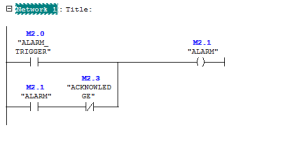Depending on circumstances, the PLC may detect an alarm condition and take an action which then causes the alarm condition to no longer be true. If this happens quickly, the HMI, which is monitoring the alarm, may never see that there was a problem, and thus the operator will not understand why the action occurred.
By "sealing" in the alarm (making the alarm itself a condition for setting the alarm, as Rob showed), the alarm persists long enough for the HMI to "see" it.
Always bear in mind that most HMIs typically only read a PLC value once per second or longer. One second is an eternity to a PLC. So some events must be captured and held, in order to build a usable interface.
But if held, the question then becomes, "what releases the hold?". While 'acknowledgement' is a common method, it is not necessarily the best. And thus is the can opened, and the worms start pouring out....






